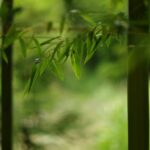Are you fascinated by the lush greenery and rapid growth of bamboo plants? Look no further – we have gathered valuable insights from an expert horticulturist who has spent years diving into the intricate world of bamboo growth patterns. Whether you’re a novice gardener or a seasoned plant enthusiast, this article will take you on a journey through the diverse habits of bamboo plants. From their remarkable emergence to their thriving nature in various conditions, this comprehensive guide offers a wealth of knowledge on the cultivation and maintenance of these versatile plants. Join us as we delve into the mesmerizing world of bamboo growth!

Bamboo Growth Habits
Bamboo is a fascinating plant that exhibits unique growth habits, influenced by various factors such as species, climate, soil conditions, sunlight, water, and overall plant health. As an experienced horticulturist with a deep understanding of bamboo growth patterns, I’m here to share valuable insights into the growth habits of this versatile plant.
Clumping Bamboo vs. Running Bamboo
The growth habits of bamboo can be broadly classified into two categories: clumping bamboo and running bamboo. Clumping bamboo tends to stay close to the parent plant, slowly spreading in an enlarging circle. On the other hand, running bamboo quickly spreads its woody rhizomes away from the parent plant. This can sometimes cause it to invade lawns and garden beds, requiring proper containment measures.
Key Insight: Clumping bamboo expands in a controlled manner, while running bamboo has a tendency to aggressively spread.
Rapid Growth and Emergence
One of the most remarkable aspects of bamboo growth is its rapid emergence. During the spring shooting period, new bamboo shoots can grow almost 4 feet in just a 24-hour period. It’s truly astonishing to witness this burst of growth! These new shoots emerge from the energy provided by the parent plant, which produces new shoots, culms (stems), and even new plants.
Key Insight: Bamboo showcases an unparalleled growth rate, especially during its shooting period in spring.
Rhizomes: The Life Force of Bamboo
Rhizomes play a crucial role in bamboo growth. These underground stems provide nutrients and support for the above-ground canes. As the rhizome system matures and provides more nutrients, the culms of bamboo gradually increase in size each year. This results in a visually stunning display as the bamboo grove flourishes and matures over time.
Key Insight: Rhizomes are essential for the sustained growth and vitality of bamboo plants.
Bamboo Forests: Different from Trees
It’s important to recognize that the growth and formation of a bamboo forest or plantation is distinct from that of trees. While trees form canopies and develop a complex network of branches, bamboo, being a type of grass, grows in clusters of canes originating from rhizomes. This unique structure gives bamboo its characteristic appearance and growth patterns.
Key Insight: Bamboo forests follow a growth pattern that is distinct from traditional tree formations.
Establishing and Maximum Size
When cultivating bamboo, it’s crucial to understand that it takes time for a new bamboo plant to establish and reach its maximum size. On average, it may take approximately three to four years for a new bamboo plant to establish itself fully. During this period, proper care and maintenance are essential for ensuring healthy growth.
Key Insight: The establishment and maximum size of a bamboo plant require time and appropriate care.
Delicate Shoots and Planting Precautions
Bamboo shoots are delicate and can be easily damaged. Therefore, caution should be exercised when planting bamboo in open ground. Proper preparation of the planting site, including weed control and soil amendment, can help create a favorable environment for the shoots to thrive.
Key Insight: Bamboo shoots require gentle handling during planting, and careful preparation of the planting site is crucial.
The Influence of External Factors
The growth habits of bamboo are significantly influenced by various external factors. Species, climatic conditions, soil quality, sunlight availability, water supply, and the overall health of the plant all contribute to the growth and development of bamboo. Understanding these factors and their impact is essential for successfully cultivating and maintaining bamboo plants.
Key Insight: External factors play a vital role in shaping the growth habits of bamboo.
Bamboo growth habits are truly fascinating, showcasing unique characteristics that distinguish them from other plants. Hopefully, this insightful exploration into the growth patterns of bamboo has deepened your understanding of this versatile plant and provided valuable guidance for its cultivation and maintenance.
Now that you have a comprehensive understanding of bamboo growth habits, it’s time to roll up your sleeves and explore the exciting world of bamboo cultivation!
Is Bamboo A Tree Or Grass? This is a question that has puzzled many nature enthusiasts. The answer may surprise you! Bamboo is actually a type of grass. Yes, you heard that right, it’s not a tree! Despite its impressive height and sturdy appearance, bamboo belongs to the grass family. If you want to learn more about the fascinating world of bamboo and its classification, click here: Is Bamboo A Tree Or Grass.

FAQ
Question 1
What are the different types of bamboo based on the growth habits of their rhizomes?
Answer 1
There are two types of bamboo based on the growth habits of their rhizomes: clumping bamboo and running bamboo. Clumping bamboo stays close to the parent plant and spreads slowly in an enlarging circle, while running bamboo quickly spreads its woody rhizomes away from the parent plant, often invading lawns and garden beds.
Question 2
How fast does bamboo grow during the Spring shooting period?
Answer 2
Bamboo has a fast growth rate, with new shoots growing almost 4 feet in a 24-hour period during the Spring shooting period.
Question 3
What is the role of rhizomes in bamboo growth?
Answer 3
Rhizomes are an important aspect of bamboo growth as they provide nutrients and support for the above-ground canes. They serve as the energy source for the growth and formation of new shoots, culms, and plants.
Question 4
How long does it take for a new bamboo plant to reach its maximum size?
Answer 4
It takes approximately three to four years for a new bamboo plant to establish and reach its maximum size.
Question 5
What factors can affect the growth habits of bamboo?
Answer 5
The growth habits of bamboo can vary depending on the species, climatic conditions, soil, sunlight, water, and overall health of the plant.
















